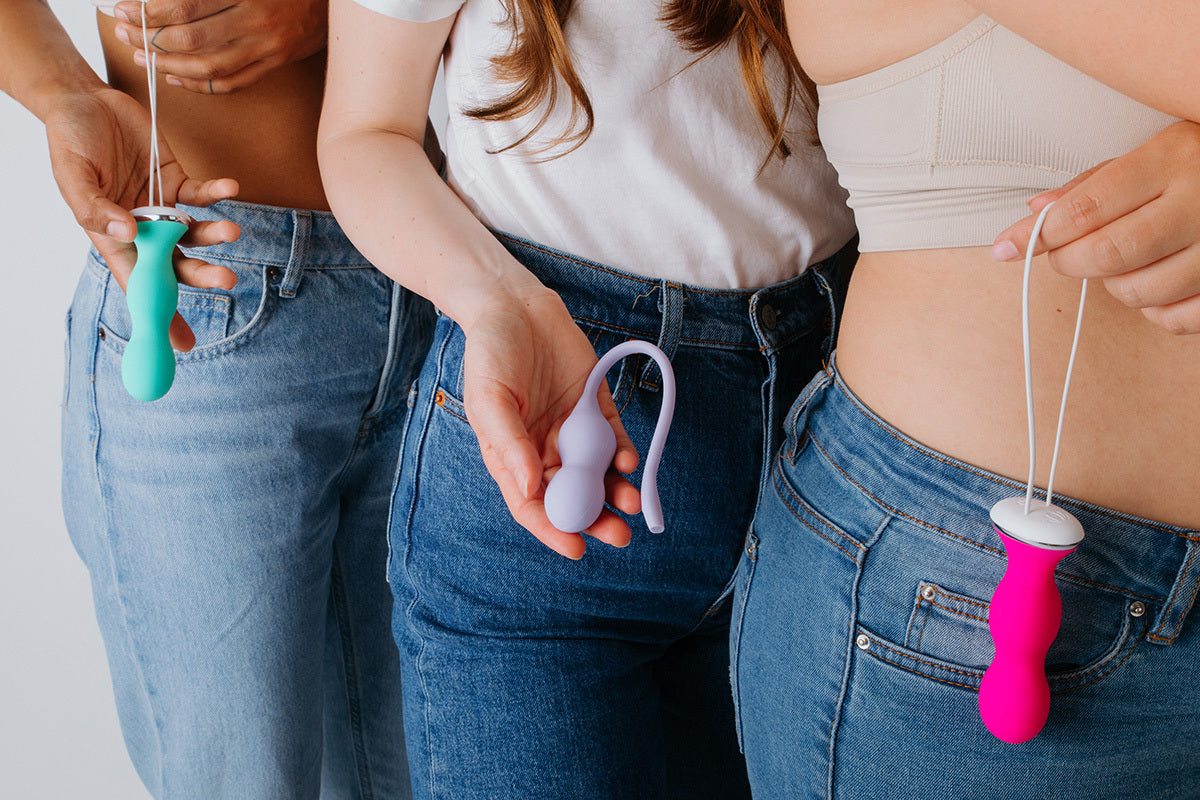Hey there, new parent! Congratulations on your little bundle of joy. Now that you're settling into life with your baby, it's time to think about your own recovery. Specifically, let's talk about your pelvic floor. Those muscles have been through a lot, and they need some TLC. In this guide, we'll walk you through everything you need to know about postpartum pelvic floor exercises. From when to start, to how to do them properly, to the amazing benefits you'll experience. We'll even introduce you to Perifit Care Kegel trainer and its handy app - your new best friend for pelvic floor training. Ready to strengthen your core and regain control? Let's dive in!
Why are postpartum pelvic floor exercises important?
Postpartum pelvic floor exercises are crucial for your recovery after childbirth. These exercises, also known as Kegels, help strengthen the muscles that support your bladder, uterus, and other pelvic organs. Pelvic floor muscle training (PFMT) can prevent and treat various pelvic floor dysfunctions common among new parents.
Benefits of pelvic floor exercises :
- Improved bladder control: Strengthening your pelvic floor muscles through regular Kegel exercises can help improve urinary incontinence by providing better support to your bladder and urethra. This is especially important after childbirth when stress incontinence is common.
- Enhanced core strength: Beyond just your pelvic floor, Kegels target the deep muscles surrounding your abdomen and lower back that form your body's core. Regular training can significantly boost your core strength over time.
- Reduced risk of pelvic organ prolapse: Consistent pelvic floor muscle training helps strengthen the muscles that support your pelvic organs in place. This reduces the likelihood of pelvic organ prolapse, a common condition after childbirth where organs shift from their normal position.
- Better sexual function: Strong pelvic floor muscles can improve arousal, increase sensation, and intensify orgasms. Regular Kegel exercise can enhance sexual function and satisfaction for both you and your partner.
Studies show (1) that antenatal PFMT during pregnancy may help prevent urinary incontinence in late pregnancy and the mid-postnatal period. While the long-term effects beyond 12 months postpartum are unclear, starting these exercises early can set you up for success. Regular pelvic floor exercises during pregnancy can strengthen pelvic floor muscles and reduce symptoms of urinary incontinence that often occur later in pregnancy.
For those struggling with motivation or proper technique, the Perifit Care Kegel trainer offers a solution. We will tell you more about it in later this article.
When to start pelvic floor exercises after birth?
Starting postpartum pelvic floor exercises at the right time is crucial for your recovery.
You should wait to start pelvic floor exercises until your body has fully healed after childbirth, typically around 6 weeks postpartum. This allows time for your incision to heal properly before engaging the core muscles. Consult your healthcare provider before beginning any exercise routine to make sure your body is ready and you are using proper technique to avoid injury.
Consulting your healthcare provider before starting any postpartum exercise routine is important. They can screen for any complications, assess your pelvic floor strength and mobility, and recommend a safe and effective program tailored to your needs.
💡 Everyone's recovery is different, so don't push yourself too hard too soon.
What are the best pelvic floor exercises for postpartum recovery?
Kegel exercises: The foundation of pelvic floor strength
Kegel exercises are the cornerstone of postpartum pelvic floor exercises. To perform Kegels correctly (2), start by identifying your pelvic floor muscles. Try to stop the flow of urine or prevent passing gas. Then, tighten and lift these muscles, holding for 3-5 seconds before releasing. Aim for 5-10 Kegels, 2-3 times daily, gradually increasing as you build strength.
Progressive exercises for a stronger core
As you recover, incorporate more challenging exercises:
Weeks 1-2
Focus on gentle pelvic floor contractions and diaphragmatic breathing for pelvic floor recovery.
Pelvic Floor Contractions:
- Tighten the muscles of your pelvic floor as if stopping the flow of urine.
- Hold for a few seconds, then relax.
- Repeat 10-15 times per set, 3 sets daily.
Diaphragmatic Breathing paired with gentle (submaximal) Kegel:
- Lie on your back or sit comfortably.
- Inhale deeply through yor nose, allowing your diaphragm (lower ribcage) and abdomen to expand.
- Exhale fully through your mouth, gently contracting your pelvic floor as you breathe out.
- Continue for 5-10 minutes to relax the pelvic floor muscles and increase awareness during recovery.
Weeks 3-4:
Add transverse abdominis activation and bridges.
Transverse Abdominis Activation:
- Lie on your back with your knees bent and feet flat on the floor.
- Inhale deeply, and as you exhale, gently pull your belly button toward your spine, activating the transverse abdominis (deep core muscles).
- Hold for 5-10 seconds, then relax.
- Repeat 10-15 times, focusing on engaging the deep core while maintaining pelvic floor control.
Bridge Pose:
- Lie on your back with your feet flat on the floor, shoulder-width apart.
- Tighten your pelvic floor and engage your glutes as you lift your hips toward the ceiling.
- Hold for a few seconds, then lower your hips back down.
- Repeat 10-15 times.
Weeks 5-6
Introduce functional movements like squats and step-ups.
Squats:
- Stand with your feet shoulder-width apart.
- Lower your body into a squat position (like sitting back into a chair), keeping your back straight and engaging your pelvic floor muscles.
- Ensure your knees do not pass over your toes.
- Stand back up and repeat 10-15 times.
Step-Ups:
- Stand in front of a step or bench.
- Step up onto the bench with one leg, engaging your core and pelvic floor as you lift your body.
- Step down and repeat with the other leg.
- Perform 10 repetitions per leg.
This gradual progression helps prepare your body for more intense activities.
Support your postpartum recovery with Perifit Care+
For precise pelvic floor training during the postpartum period, consider the Perifit Care+ Kegel trainer an innovative solution. This nifty Kegel exerciser is designed to make pelvic exercises after giving birth both effective and, dare we say, fun!
Perifit Care+ combines a small device with a user-friendly app. Insert the device, then use the app to guide you through pelvic floor exercises. It's like having a personal trainer for your pelvic muscles! It makes your recovery journey more engaging and effective.
Regular use of Perifit Care+ can help:
- Improve bladder control
- Reduce urinary incontinence
- Enhance core strength
Plus, it takes the guesswork out of post-pregnancy pelvic exercises. The app tracks your progress, ensuring you're doing the exercises correctly and consistently.
With Perifit Care+, you're taking a proactive step towards a stronger, healthier pelvic floor.
What are common mistakes to avoid when doing pelvic floor exercises postpartum?
Improper technique
One of the most common mistakes is not engaging the correct muscles. Many people inadvertently contract their abdominal, thigh, or buttock muscles instead of isolating the pelvic floor. This can lead to ineffective exercises and potential strain. To avoid this, focus on the sensation of lifting and squeezing internally as if trying to stop the flow of urine.
Overexertion and lack of relaxation
Repeatedly performing contractions without proper relaxation can lead to pelvic floor overactivity (4), potentially worsening symptoms. Remember, the ability to relax these muscles is just as important as strengthening them. Incorporate both contraction and relaxation phases into your routine.
Inconsistency and impatience
Postpartum pelvic floor exercises require consistency and time to show results. Failing to perform the exercises regularly or expecting immediate improvements can hinder progress. Aim for multiple sessions throughout the day and be patient with your body's healing process.
Are pelvic floor exercises safe during breastfeeding?
Absolutely! Pelvic floor exercises are not only safe but highly beneficial during the breastfeeding period. You can start gentle exercises, including pelvic floor workouts, as soon as you feel up to it after a straightforward birth. These exercises help strengthen the muscles stretched during pregnancy and childbirth.
Moderate exercise, including pelvic floor workouts, doesn't affect breast milk quality or quantity (5). However, it's crucial to listen to your body and not overdo it. If you're looking for a fun and effective way to strengthen your pelvic floor, consider trying the Perifit Care Kegel trainer. This innovative device, paired with its app, can guide you through personalized postnatal pelvic floor exercises, making your recovery journey both enjoyable and efficient.
Do you need to see a physical therapist for postpartum pelvic floor exercises?
Seeing a pelvic floor physical therapist can be incredibly beneficial for postpartum recovery. These specialists can help diagnose and treat pelvic floor problems that may arise during pregnancy or after childbirth, such as urinary incontinence or pelvic pain.
A physical therapist can provide personalized guidance on performing postnatal pelvic floor exercises correctly and safely. They'll assess your individual needs and create a tailored program to help strengthen your pelvic floor muscles effectively.
Alright, new parent, you've got this! Pelvic floor exercises are your secret weapon for a strong postpartum recovery. Start slow, listen to your body, and gradually build up your routine. The benefits are huge - better bladder control, a stronger core, and reduced risk of pelvic organ prolapse. Don't forget to check out tools like the Perifit Care Kegel trainer and app to make your exercises more effective and fun. Your pelvic health is crucial, so give it the attention it deserves. With consistent practice and patience, you'll be feeling stronger and more confident in no time. You've already done the hard part by giving birth - now it's time to take care of you!
Sources:
- https://pmc.ncbi.nlm.nih.gov/articles/PMC6486304/
- https://medlineplus.gov/ency/article/003975.htm
- https://pmc.ncbi.nlm.nih.gov/articles/PMC9528725/
- https://pmc.ncbi.nlm.nih.gov/articles/PMC9528725/
- https://www.mayoclinic.org/healthy-lifestyle/labor-and-delivery/in-depth/exercise-after-pregnancy/art-20044596





